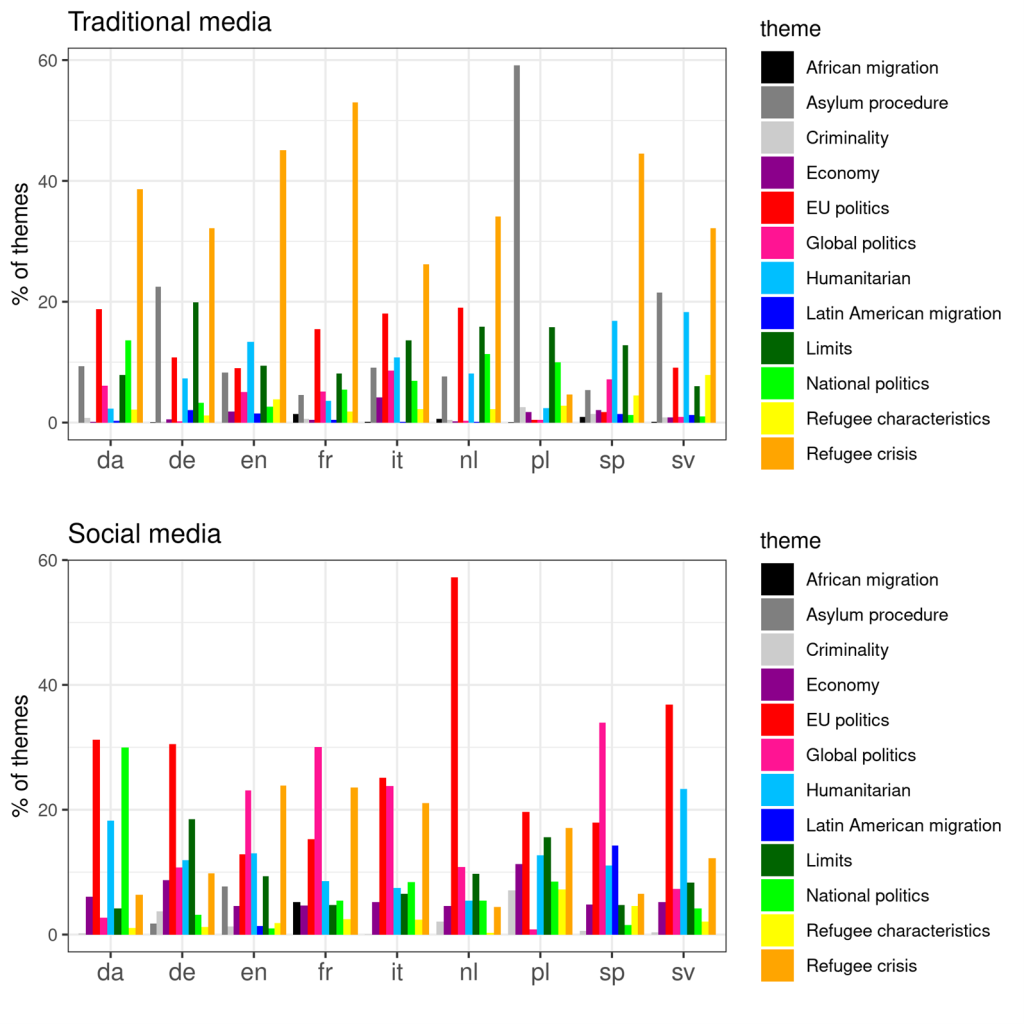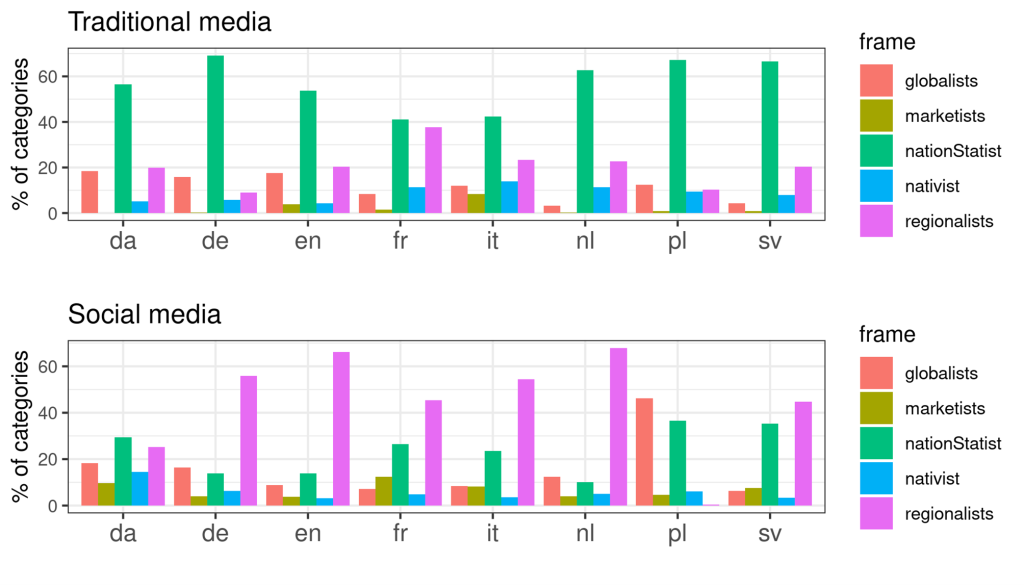Comparing the discourse on refugees and migrants in Europe across traditional and social media
by Anamaria Dutceac Segesten and Mike Farjam from Lund University
Social and traditional media have very different goals, ways of presenting information, and audiences when they discuss migration and refugees. In this blog, we summarize the results of our comparative analysis of the two types of media, across nine languages, with respect to content about the so-called “migrant crisis”. We find across all nine languages that traditional media discusses migration primary through the Nation Statist lens, which means that the issue of migration is placed primarily in the context of domestic politics and national laws. Social media, on the other hand, focuses far more on the European dimension of the crisis and on the EU-level actors. This presents further evidence that social media are contributing to a European public sphere that encompasses both pro- and against migration discourses.
We analyzed ~16 million social media posts (Twitter, Youtube and Reddit) and ~2 million news articles across nine different languages (English, Spanish, German, French, Italian, Dutch, Swedish, Danish and Polish).
The posts were selected using similar query criteria. We dissected the discourse along two dimensions. First, we identified specific themes present across the different language and media groups. Second, we identified lenses (so called “frames”) through which these themes appeared. As an example, the economic consequences of the migrant crisis can be discussed as mainly affecting domestic job markets or straining national budgets (this would fall under the Nation-Statist category). The same topic may also place an emphasis of the European dimension of the issue and the role that EU actors played in supporting helpful policies (this would fall under the Regionalist category).
Our core idea is to see whether, across languages and media types, the same themes are discussed and whether they are discussed in the same way or whether we have a fragmented discourse.
Commonalities across languages, differences between media types
We used computational methods to identify keywords and the context in which these appeared within our media data. We then used human qualitative coders to sort these keywords into different themes and frames.
The graph below (Figure 1) shows the main topics that within each language and media type. It is immediately visible that the distribution of themes drastically differs between social and traditional media.
Within traditional media, the theme Refugee crisis is clearly dominating. This theme deals with stories and specific events linked to refugees such as the events at the Hungarian border during 2015, or the sinking of a specific boat with refugees in the Mediterranean Sea.
Interestingly, this distribution of themes is relatively consistent across languages with the notable exception of Polish, where the main themes were Asylum Procedure (dealing with legal questions and definitions of asylum) and Limits to asylum/migration.

Themes
We see much more variety regarding themes in the social media.
The most common topics are (in order of frequency) EU politics, global politics, and, only on third place, the theme Refugee Crisis (which was the most popular one on traditional media).
Social media thus seem to be the place were discussions that go beyond individual events are taking place and where in particular trans-national aspects of the crisis were discussed.
Frames
A similar pattern emerges when analyzing the frames through which these themes were discussed (see Figure 2).
The themes are relatively consistent across languages, but clearly different between media types.
The graph below shows the distribution of frames and shows that the Nation Statist frame dominated within traditional media, while on social media the Regionalists were most prevalent.
According to the theoretical framework used in our project, the Nation Statists are those who place migration and asylum primarily in the context of domestic politics, laws and institutions. Regionalists, on the other hand, emphasize regional cooperation between states, the role that institutions like the EU have to play, and trans-national identities.
Other frames only play a minor role, but again the Polish content significantly diverges from the rest, with an apparent polarization between the Nation Statists and Globalists (emphasizing the global dimension of migration and referring to institutions like the UN).

Summary
In sum, our comparison reveals that the most significant differences in both topics and frames is not between countries but between media types.
The exception here is the Polish content, which deviates from the other languages’ trends.
Traditional media
Traditional media is dominated by the Nation Statist frame, which can be explained by the constraints of this type of news: being published within a national media industry, by journalists trained to address the national public.
Media elites want to ensure the attention and interest of their (national) publics, so they resort to a national angle even when discussing remote events.
It is interesting that this effort to “translate” in national terms migration and refugees is the same, regardless of the respective national policies on asylum and migration.
Social media
On social media, our research paints a different picture.
Here the regionalist frame is the most frequent, which may underline the transnational nature of conversation in this borderless medium; this may support the description of the digital content on migration as Europeanized.
The different with the traditional media may also be explained by the non-elite origin of much of social media content. Here we are not dealing with professional journalists that are trained in and want to adhere to national standards of professionalism. On social media, the commentary is free-flowing and expert and non-expert voices are mixed.
The digital territory is also an arena where EU institutions can bypass the mediation of national media houses and reach out to citizens directly.
One final potential explanation is that social media has been used as an organizing means for non-governmental organizations, social movements and activist groups that sought to unite across borders for a common cause (in our case, migration).
To conclude
These different frames may be seen as both being an expression of and an influence on the public opinion in the respective language clusters.
This may mean that different types of media exert different kinds of pressure on policymakers.
